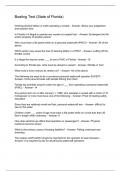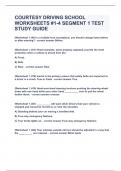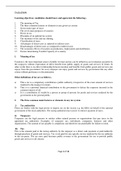TOPIC 3 – Atoms, Elements & Compounds
· PROTONS, ELECTRONS & NEUTRONS:
- Proton / Atomic Number = number of protons in the nucleus an atom.
- Nucleon / Mass Number = total number of protons and neutrons in the nucleus of an atom.
· ELECTRONIC STRUCTURE DIAGRAM OF AN ELEMENT:
(Na - Sodium)
- First Shell (Max.) : 2
- Second Shell (Max.) : 8
- Third Shell (Max.) : 8
- Elements will react to obtain full outer shells because that is the most stable arrangement, usually
elements complete them with 8 electrons but elements with only one shell will complete it with only
two electrons.
· THE PERIODIC TABLE & ITS ARRANGEMENT:
- Periods = elements are arranged in order of increasing atomic number in rows / periods.
- Groups = elements with similar properties are placed in the same columns / groups.
- Elements in the same group have the same number of electrons in their outer shell.
- Group 8 Elements = nobles gases have 8 electrons in their outer shells already (except helium, which
has 2), making them very stable so unreactive.
, · THE PERIODIC TABLE:
· ISOTOPES:
- Isotopes = atoms of the same element which have the same proton number but a different nucleon
number (different number of neutrons).
- They have the same chemical properties because they have the same number of electrons in their
outer shell and the number of electrons in the outer shell is responsible for chemical reactions.
- They also have the same number of protons so are still classed as the same element.
- Types of Isotopes:
- Radioactive: medical use – tracers and sterilising equipment, industrial use - smoke alarms and tracers.
- Non-radioactive
· ELEMENTS, MIXTURES & COMPOUNDS:
- Element = substance made from only one type of atom.
- Compound = substance made from two or more elements that have reacted chemically with each other.
- Mixture = 2 or more elements or compounds not chemically combined together. Chemical properties of
each substance in the mixture are unchanged.
· IONS:
- an ion is an atom or group of atoms with a positive or negative charge.
- ions are formed by an atom losing or gaining electrons (which have a -1 charge).
- if an atom gains electrons, it becomes an anion (negative ion).
- if an atom loses electrons, it becomes a cation (positive ion).
· METALS AND NON-METALS:
- Metals = elements that lose electrons to form positive ions. Most elements are metals, they’re the best
conductors of electricity.
- Non-metals = elements that gain electrons to form negative ions. Generally non-conductive (except
graphite).
· ALLOYS:
- Alloys = a mixture of a metal with other elements. (i.e. brass or gold in jewellery)
- Alloys are harder than pure metals because the positive ions have different sizes and so there isn’t a
perfect regular arrangement which prevents the ions from sliding over each other as easily.
· PROTONS, ELECTRONS & NEUTRONS:
- Proton / Atomic Number = number of protons in the nucleus an atom.
- Nucleon / Mass Number = total number of protons and neutrons in the nucleus of an atom.
· ELECTRONIC STRUCTURE DIAGRAM OF AN ELEMENT:
(Na - Sodium)
- First Shell (Max.) : 2
- Second Shell (Max.) : 8
- Third Shell (Max.) : 8
- Elements will react to obtain full outer shells because that is the most stable arrangement, usually
elements complete them with 8 electrons but elements with only one shell will complete it with only
two electrons.
· THE PERIODIC TABLE & ITS ARRANGEMENT:
- Periods = elements are arranged in order of increasing atomic number in rows / periods.
- Groups = elements with similar properties are placed in the same columns / groups.
- Elements in the same group have the same number of electrons in their outer shell.
- Group 8 Elements = nobles gases have 8 electrons in their outer shells already (except helium, which
has 2), making them very stable so unreactive.
, · THE PERIODIC TABLE:
· ISOTOPES:
- Isotopes = atoms of the same element which have the same proton number but a different nucleon
number (different number of neutrons).
- They have the same chemical properties because they have the same number of electrons in their
outer shell and the number of electrons in the outer shell is responsible for chemical reactions.
- They also have the same number of protons so are still classed as the same element.
- Types of Isotopes:
- Radioactive: medical use – tracers and sterilising equipment, industrial use - smoke alarms and tracers.
- Non-radioactive
· ELEMENTS, MIXTURES & COMPOUNDS:
- Element = substance made from only one type of atom.
- Compound = substance made from two or more elements that have reacted chemically with each other.
- Mixture = 2 or more elements or compounds not chemically combined together. Chemical properties of
each substance in the mixture are unchanged.
· IONS:
- an ion is an atom or group of atoms with a positive or negative charge.
- ions are formed by an atom losing or gaining electrons (which have a -1 charge).
- if an atom gains electrons, it becomes an anion (negative ion).
- if an atom loses electrons, it becomes a cation (positive ion).
· METALS AND NON-METALS:
- Metals = elements that lose electrons to form positive ions. Most elements are metals, they’re the best
conductors of electricity.
- Non-metals = elements that gain electrons to form negative ions. Generally non-conductive (except
graphite).
· ALLOYS:
- Alloys = a mixture of a metal with other elements. (i.e. brass or gold in jewellery)
- Alloys are harder than pure metals because the positive ions have different sizes and so there isn’t a
perfect regular arrangement which prevents the ions from sliding over each other as easily.






